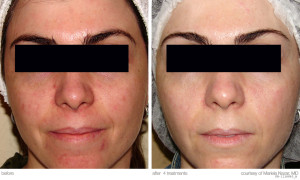Is There Any Difference Between Laser Vs. IPL When Treating Redness, Rosacea or Veins
If you ask around, you’ll hear that lasers are “the gold standard” for both hair removal and for treating skin disorders, such as rosacea; however, this “goal standard” reputation really only holds in a few specific cases.
For example, for hair removal, the diode laser at 810nm is extremely effective for any hair color or type; however, unless you have very light or blond hair, IPL is just as effective.
What’s The Difference Between Laser VS. IPL?
A laser produces an intense beam of light composed of one wavelength that targets a specific body structure, e.g., a hair follicle or a red blood cell; IPL (short for ‘intense pulsed light’), on the other hand, rather than producing a sustained beam of light, produces a series of intense short flashes. Unlike a laser, IPL light is composed of many wavelengths, but to target a specific body structure, technicians use filters to narrow the focus of the light.
The main overall advantage of IPL over lasers is efficiency in treating different skin problems: the pulsed light allows for an accumulation of energy (heat) on the target under the surface of the skin while letting the surface of the skin cool and recover between pulses; this, coupled with the use of filters, allows for rapid shifting of frequencies to treat different conditions.
Additionally, IPL can treat a larger area than a laser which results in less treatment time for large areas of rosacea.
So for Rosacea & Veins, Which is Better, IPL or Laser?

BEFORE & AFTER IPL TREATMENT: Rosacea is a common but poorly understood disorder of the facial skin that can be helped with IPL treatment
You’re far more likely to experience significant treatment outcomes depending on the quality of equipment used and the skill level and experience of the technician than you are on whether or not you use laser or IPL; in fact, controlling for the quality of equipment and the experience level of the technician, major studies have found either no or little difference in treatment outcomes or a small advantage of laser in special cases.
For example, a 2007 study reported in the Annals of Plastic Surgery found no difference between intense pulsed light versus a long-pulse pulsed dye laser in the treatment of facial skin rejuvenation (Ann Plast Surg. 2007 Nov;59(5):479-83); it did find, however, that laser was superior to IPL in the treatment of lentigines. Other studies have found an IPL advantage over pulsed-dye laser in the treatment of facial acne and port-wine stain.
In short, in the right hands, in most cases, both technologies produce excellent results.
What About Bruising After Treatment?
To be on the safe side, you should probably expect some bruising after IPL treatment for rosacea. However, you can reduce the possibility of bruising by not taking blood thinners, like aspirin, Advil or Aleve within a week of your treatment.
Because we see bruising on some clients after IPL treatment for rosacea, we do not recommend IPL (both hair & photo facial) for our clients during summer.
What About Downtime After Treatment?
While there is very little, if any, downtime after treatment, if you work on camera, especially given today’s high definition cameras, you may have a wait a day or so before you become camera ready; however, if you don’t work on camera, you can apply makeup after treatment and then go right back into your normal routine.
